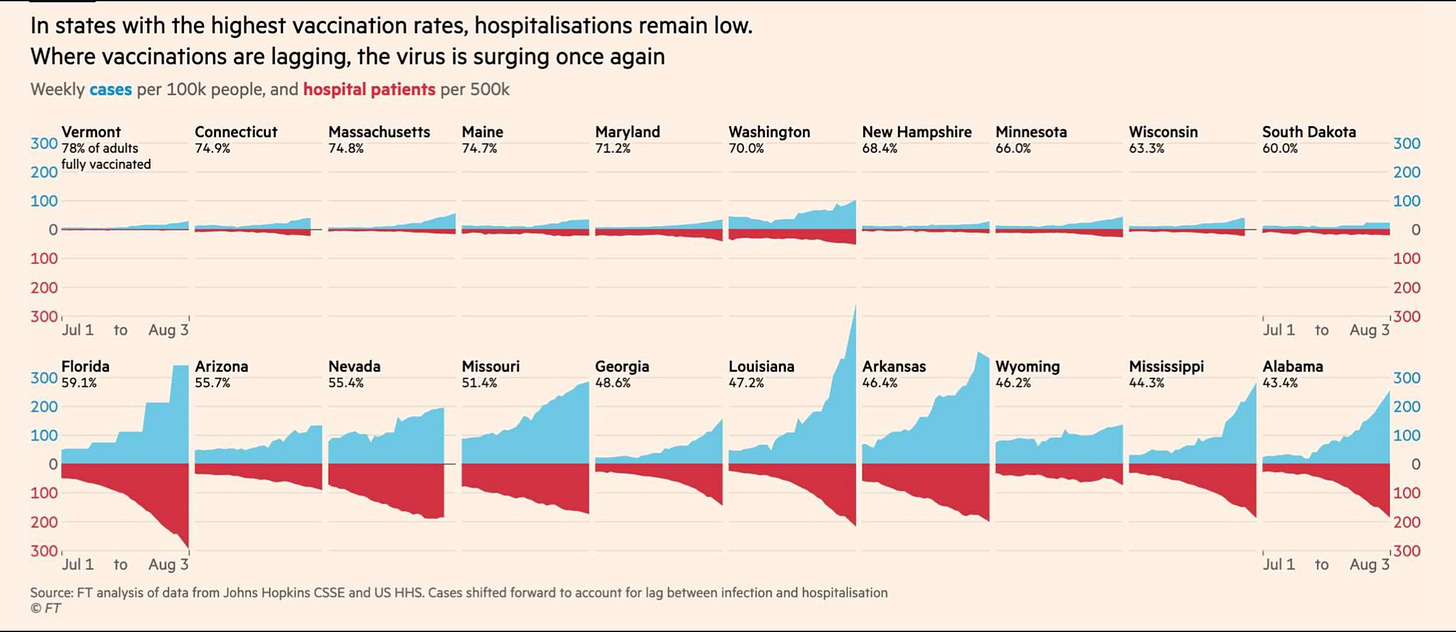Among humans the only event that is statistically 100% is eventual death (and, as some point out, taxes). Vaccines are not 100%—and the current vaccines against Covid-19 were never advertised that way. Moreover, they were tested and approved (under an EUA, an emergency use authorization) against the original genetic version of SARS-CoV-2. The Pfizer vaccine was found 95% percent effective: In a study population of nearly 22,000 unvaccinated people and 22,000 people 7 days after their second shot, people out in the community, 170 study subjects developed test positive, symptomatic Covid-19, one hundred sixty-two in the unvaccinated group and eight in the vaccinated group. 162/170=0.95 or 95%. That’s where the 95% number came from. It was never advertised as 100%. The study was exhaustive, clear science, not speculation or anecdote. It was a triumph—but it was not 100%—and it was tested only against the original virus.
People like simple statements, “If you are vaccinated you are totally protected and you can toss caution to the wind,” but nothing in life is 100%. There are always people who, by reason of their genetics, the state of their immune system, or some other factor do not develop immunity to a disease against which they were vaccinated. Protection for those people depends on a sufficiently high rate of vaccination in the community that the target virus cannot gain a foothold and spread. People who got the vaccination but for whom it didn’t “take” or the few who, for one reason or another, were not vaccinated depend on the statistical immunity of the “herd” to protect them from the disease.
Notice that the Pfizer study, even with the original virus, had eight cases, “breakthrough cases”, if you will. Also notice that the original study did not conclusively tell us whether Covid-19 could be carried and transferred by completely asymptomatic vaccinated individuals. (Although, I believe, subsequent studies suggested that such carriage and transmission was rare, at least with the original virus.)
Now we are dealing with the delta variant of SARS-CoV-2 (aka B.1.617.2), a variant with a naturally selected genetic ability to evade some of the immune defenses even of vaccinated people. “Breakthrough cases” are more common with the delta variant. Carriage and transmission of Covid-19 by asymptomatic vaccinated individuals is also more common with this variant. The original 95% number was not wrong—not then—but if that huge study were repeated today in the U.S. population where the delta variant now makes up around 85% of the Covid-19 cases, the efficacy % of the Pfizer vaccine would be lower.
Is it still worthwhile to be vaccinated? Yes, as illustrated by the following graph:
Fully vaccinated individuals are less likely to develop any symptoms of Covid-19 by a factor of 1 to 8, less likely to wind up in the hospital if they do develop symptoms by 1 to 25, and less likely die if they do wind up in the hospital also by a factor of 1 to 25.
Furthermore there is some good early evidence from Singapore that although infected vaccinated individuals carry similar loads of virus initially to the viral load of an infected unvaccinated individual, the vaccinated people shed virus on average for a shorter time, nine compared to sixteen days. Presumably this represents the faster ramp up of immunity among the vaccinated as compared to the unvaccinated.
What we do not know with any certainty is the prevalence of asymptomatic delta variant carriage among vaccinated people, nor do we know how often asymptomatic vaccinated people transmit the delta variant to others. That lack of clarity, combined with the knowledge that some asymptomatic or pre-symptomatic vaccinated people can and have spread the disease to others is the reason for the recommendation to return to mask wear indoors.
Data on vaccination rates and rate of Covid-19 hospitalization among the states is pretty striking and certainly demonstrates a correlation between higher vaccination rates and a lower the level of spread of the virus, hospitalization, and death.
So what is the outlook for eastern Washington and Idaho? The data I cite here comes from the New York Times database and the Johns Hopkins Coronavirus Tracker. Overall, as noted above, 70% of Washingtonians are vaccinated, but eastern Washington is distinct: 49% of Spokane County residents are vaccinated and the percentage drops to 30 and 31% in Stevens and Pend Oreille Counties north of here, some of the lowest numbers in the state. Idaho overall hovers around 40%, but our neighbors in all the northern Idaho counties are closer to 30%. Eastern Washington and northern Idaho have vaccination rates lower than the southern states that are now struggling with the delta variant.
The test positivity rate (TPR) offers a hint of our future. The higher the percentage of tests for Covid-19 that come back positive the greater the likely reservoir of untested, infected individuals in the community. States with high vaccination rates are showing test positivity rates under 5%. What is Idaho’s overall TPR? It rates third with 35.9% of Covid-19 tests coming back positive. Only Oklahoma and Mississippi are higher. Most of the southern states in which the virus is rampant have TPRs in the teens and twenties.
Viruses don’t respect land borders. We in eastern Washington are more akin to Idaho than Seattle, and Idaho is quite likely to be facing a tsunami of delta variant Covid-19. Anyone who is not vaccinated ought to understand the risk they are taking. Full immunity from vaccination takes five or six weeks from the first shot. A wait-and-see approach is foolhardy. Those of us already vaccinated ought to be taking precautions, first and foremost wearing masks indoors and the unvaccinated need to heed the science.
Keep to the high ground,
Jerry
P.S. Should you get vaccinated if you have had (or think you have had) Covid? Read this: “‘Natural’ immunity protection and variants”. Also, a recent study published on the CDC website.




